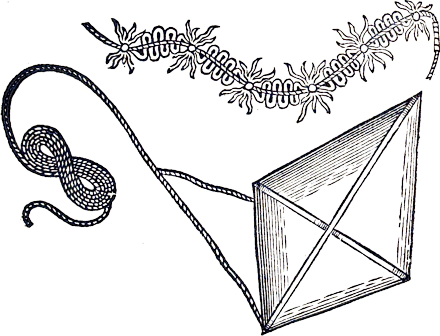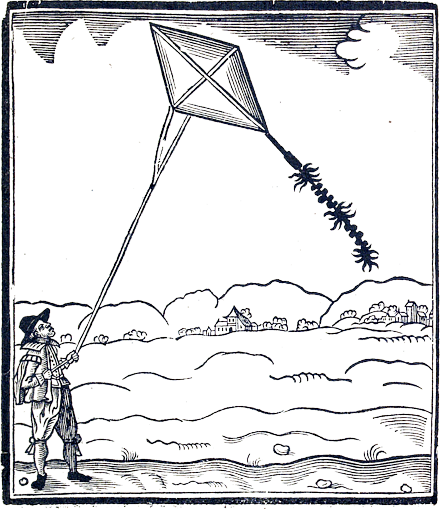![]()
I was visiting the British Library recently and saw a picture of a kite in a book in a display case. It turned out to be the oldest English picture of a kite, and one of the oldest in Europe. The book was John Bate's The Mysteryes of Nature and Art, dated 1634. It shows a kite being used as a Fire Drake (a fire drake in Germanic mythology is a fiery dragon and drachen is German for kite). Some of you will recognise the main image, as it is shown in Pelham's Kites, but I have reproduced the article in full in the original English.
How to make fire Drakes
You muſt take a peece of linnen cloth of a yard or more in length; it muſt bee cut after the forme of a pane of glaſſe; faſten two light ſtickes croſſe the ſame, to make it ſtand at

breadth; then ſmeare it over with linſeed oyle, and liquid varniſh tempered together, or else wet it with oyle of peter, and unto the longeſt corner faſten a match prepared with ſalpeter water (as I have taught before) upon which you may faſten divers crackers, or Sauciſſons; betwixt every of which, binde a knot of paper ſhavings, which will make it flye the better; within a quarter of a yard of the cloth, let there bee bound a peece of prepared ſtoupell*, the one end whereof, let touch the cloth, and the other

enter into the end of a Sauciſſon: then tie a ſmall rope of length ſufficient to rayſe it unto what heighth you shall deſire, and to guide it withall: then fire the match, and rayſe it againſt the winde in an open field; and as the match burneth, it will fire the crackers, and ſauciſſons, which will give blowes in the ayre; and when the fire is once come unto the ſtoupell, that will fire the cloth, which will ſhew very ſtrangely and fearefully.
It's interesting to note the use of the word saucissons for fireworks. Saucisson is French for sausages and in English slang, sausages are bangers (fireworks).
* Stoupell (also stouple, stopple) - a quick-match, a fuse. A quick-burning match used for firing cannon, igniting fire-works, shells, etc., consisting of cotton-wick soaked in a composition of gum, spirits, water and gunpowder.
Reproduction rights remain with the British Library. To contact them for use of the text or images you will need to quote the following:
1651/1378
John Bate
The Mysteryes of Nature and Art
(1634)
pp118-120